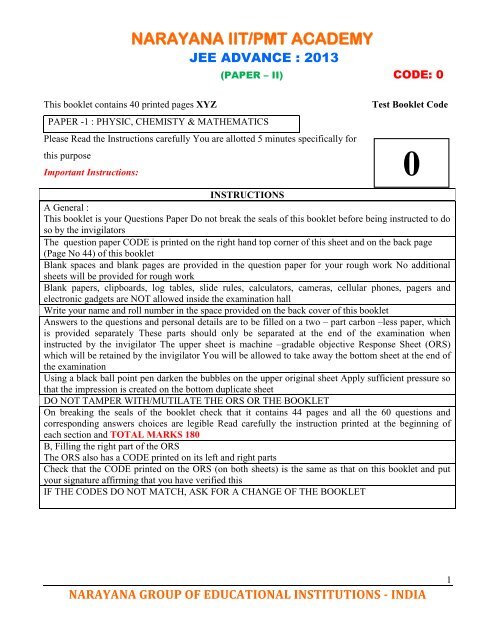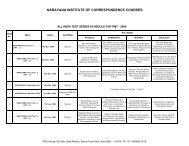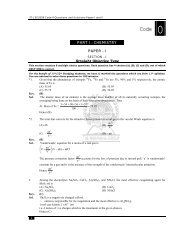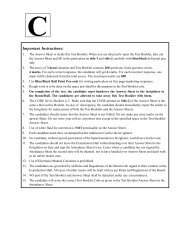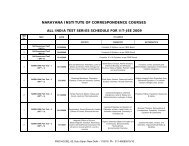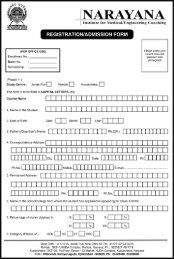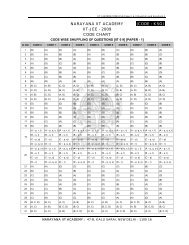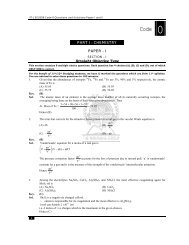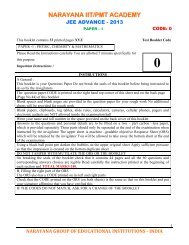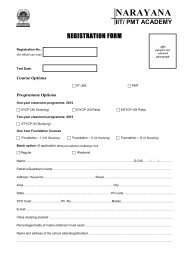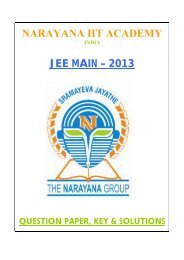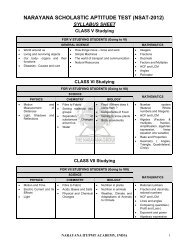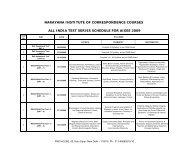NARAYANA IIT/PMT ACADEMY - Narayanaicc.com
NARAYANA IIT/PMT ACADEMY - Narayanaicc.com
NARAYANA IIT/PMT ACADEMY - Narayanaicc.com
Create successful ePaper yourself
Turn your PDF publications into a flip-book with our unique Google optimized e-Paper software.
<strong>NARAYANA</strong> <strong>IIT</strong>/<strong>PMT</strong> <strong>ACADEMY</strong><br />
JEE ADVANCE : 2013<br />
(PAPER – II) CODE: 0<br />
This booklet contains 40 printed pages XYZ<br />
PAPER -1 : PHYSIC, CHEMISTY & MATHEMATICS<br />
Please Read the Instructions carefully You are allotted 5 minutes specifically for<br />
this purpose<br />
Important Instructions:<br />
Test Booklet Code<br />
0<br />
INSTRUCTIONS<br />
A General :<br />
This booklet is your Questions Paper Do not break the seals of this booklet before being instructed to do<br />
so by the invigilators<br />
The question paper CODE is printed on the right hand top corner of this sheet and on the back page<br />
(Page No 44) of this booklet<br />
Blank spaces and blank pages are provided in the question paper for your rough work No additional<br />
sheets will be provided for rough work<br />
Blank papers, clipboards, log tables, slide rules, calculators, cameras, cellular phones, pagers and<br />
electronic gadgets are NOT allowed inside the examination hall<br />
Write your name and roll number in the space provided on the back cover of this booklet<br />
Answers to the questions and personal details are to be filled on a two – part carbon –less paper, which<br />
is provided separately These parts should only be separated at the end of the examination when<br />
instructed by the invigilator The upper sheet is machine –gradable objective Response Sheet (ORS)<br />
which will be retained by the invigilator You will be allowed to take away the bottom sheet at the end of<br />
the examination<br />
Using a black ball point pen darken the bubbles on the upper original sheet Apply sufficient pressure so<br />
that the impression is created on the bottom duplicate sheet<br />
DO NOT TAMPER WITH/MUTILATE THE ORS OR THE BOOKLET<br />
On breaking the seals of the booklet check that it contains 44 pages and all the 60 questions and<br />
corresponding answers choices are legible Read carefully the instruction printed at the beginning of<br />
each section and TOTAL MARKS 180<br />
B, Filling the right part of the ORS<br />
The ORS also has a CODE printed on its left and right parts<br />
Check that the CODE printed on the ORS (on both sheets) is the same as that on this booklet and put<br />
your signature affirming that you have verified this<br />
IF THE CODES DO NOT MATCH, ASK FOR A CHANGE OF THE BOOKLET<br />
<strong>NARAYANA</strong> GROUP OF EDUCATIONAL INSTITUTIONS - INDIA<br />
1
<strong>NARAYANA</strong> <strong>IIT</strong>/<strong>PMT</strong> <strong>ACADEMY</strong><br />
JEE ADVANCE : 2013<br />
(PAPER – II) CODE: 0<br />
PART I : PHYSICS<br />
SECTION -1 : (One or more options correct Type)<br />
The section contains 8 multiple choice questions Each question has four choices (A), (B), (C) and (D)<br />
out of which ONE and MORE are correct<br />
1 The figure below shows the variation of specific heat capacity (C) of a solid as a function of<br />
temperature (T) The temperature is increased continuously from 0 to 500 K at a constant rate<br />
Ignoring any volume change, the following statement(s) is (are) correct to a reasonable<br />
approximation<br />
(A) the rate at which heat is absorbed in the range 0-100 K varies linearly with temperature T<br />
(B) heat absorbed in increasing the temperature from 0-100 K is less than the heat required for<br />
increasing the temperature from 400-500 K<br />
(C) there is no change in the rate of heat absorption in the range 400-500 K<br />
(D) the rate of heat absorption increases in the range 200-300 K<br />
C<br />
100 200 300 400 500<br />
T(K)<br />
Ans A, B, C, D<br />
Sol: dQ CdT and C varies linearly with T<br />
(A) is correct<br />
Area under the graph in the range O-100 k is less than area under 400-500 K range<br />
(B) is correct<br />
In the range 400 – 500 K, C is constant<br />
(C) is correct<br />
In the range 200 – 300 K, C is increasing<br />
(D) is correct<br />
2 The radius of the orbit of an electron in a hydrogen-like atom is 45 a 0 , where a 0 is the Bohr<br />
radius Its orbital angular momentum is 3h It is given that h is Planck constant and R is Rydberg<br />
2<br />
constant The possible wavelength(s), when the atom de-excites, is (are)<br />
9<br />
9<br />
(A)<br />
(B)<br />
32R<br />
16R<br />
2<br />
<strong>NARAYANA</strong> GROUP OF EDUCATIONAL INSTITUTIONS - INDIA
Ans<br />
Sol:<br />
9<br />
(C)<br />
5R<br />
A, C<br />
2<br />
an<br />
o<br />
Z<br />
4.5 a o<br />
nh 3h<br />
2 2<br />
n 3, z 2<br />
Now,<br />
<strong>NARAYANA</strong> <strong>IIT</strong>/<strong>PMT</strong> <strong>ACADEMY</strong><br />
JEE ADVANCE : 2013<br />
1 2 1 1<br />
Rz<br />
x x<br />
2 2<br />
1 2<br />
Possible wavelengths are<br />
9 9 1<br />
, and<br />
(PAPER – II) CODE: 0<br />
4<br />
(D)<br />
3R<br />
5R 32R 3R<br />
3 Using the expression 2d sin = , one calculates the values of d by measuring the corresponding<br />
angles in the range 0 to 90 o The wavelength is exactly known and the error in is constant<br />
for all values of As increases from 0 o<br />
Ans<br />
Sol:<br />
(A) the absolute error in d remains constant (B) the absolute error in d increases<br />
(C) the fractional error in d remains constant (D) the fractional error in d decreases<br />
D<br />
d<br />
2sin<br />
d cosec<br />
2<br />
cot<br />
Now<br />
d<br />
d<br />
cot<br />
As increases, fractional error decreases<br />
4 Two non-conducting spheres of radii R 1 and R 2 and carrying uniform volume charge densities +<br />
and – , respectively, are placed such that they partially overlap, as shown in the figure At all<br />
points in the overlapping region,<br />
(A) the electrostatic field is zero<br />
(B) the electrostatic potential is constant<br />
(C) the electrostatic field is constant in magnitude (D) the electrostatic field has same direction<br />
R 1 R 2<br />
-<br />
<strong>NARAYANA</strong> GROUP OF EDUCATIONAL INSTITUTIONS - INDIA<br />
3
Ans<br />
Sol:<br />
C, D<br />
In the overlapping region<br />
r r<br />
1 2<br />
<strong>NARAYANA</strong> <strong>IIT</strong>/<strong>PMT</strong> <strong>ACADEMY</strong><br />
JEE ADVANCE : 2013<br />
(PAPER – II) CODE: 0<br />
E 3<br />
o 3 r o<br />
r<br />
1r 2<br />
o<br />
r<br />
l<br />
l<br />
E 3<br />
C and D are correct<br />
5 A steady current I flows along an infinitely long hollow cylindrical conductor of radius R This<br />
cylinder is placed coaxialy inside an infinite solenoid of radius 2 R The solenoid has n turns per<br />
unit length and carries a steady current I Consider a point P at a distance r from the <strong>com</strong>mon axis<br />
The correct statement (s) is (are)<br />
(A) In the region 0 < r < R, the magnetic field is non-zero<br />
(B) In the region R < r < 2R, the magnetic field is along the <strong>com</strong>mon axis<br />
(C) In the region R < r < 2R, the magnetic field is tangential to the circle of radius r, centered on<br />
the axis<br />
(D) In the region r > 2R, the magnetic field is non-zero<br />
Ans A, C, D<br />
Sol: B Bhollow B<br />
solenoid<br />
conductor<br />
B due to hollow conductor is zero inside the conductor and non-zero outside (co-axial) while B<br />
due to solenoid is zero outside the solenoid and non-zero inside the solenoid (axial)<br />
R<br />
2R<br />
A, C & D<br />
6 Two vehicles, each moving with speed u on the same horizontal straight road, are approaching<br />
each other Wind blows along the road with velocity w One of these vehicles blows a whistle of<br />
frequency f 1 An observer in the other vehicle hears the frequency of the whistle to be f 2 The<br />
speed of sound in still air is V The correct statement (s) is (are)<br />
(A) If the wind blows from the observer to the source, f 2 > f 1<br />
(B) If the wind blows from the source to the observer, f 2 > f 1<br />
(C) If the wind blows from observer to the source, f 2 < f 1<br />
(D) If the wind blows from the source to the observer, f 2
<strong>NARAYANA</strong> <strong>IIT</strong>/<strong>PMT</strong> <strong>ACADEMY</strong><br />
JEE ADVANCE : 2013<br />
(PAPER – II) CODE: 0<br />
7 Two bodies, each of mass M, are kept fixed with a separation 2L A particle of mass m is<br />
projected from the midpoint of the line joining their centres, perpendicular to the line The<br />
gravitational constant is G The correct statement(s) is (are)<br />
(A) The minimum initial velocity of the mass m to escape the gravitational field of the two<br />
Ans<br />
Sol:<br />
GM<br />
bodies is 4<br />
L<br />
(B) The minimum initial velocity of the mass m to escape the gravitational field of the two<br />
GM<br />
bodies is 2<br />
L<br />
(C) The minimum initial velocity of the mass m to escape the gravitational field of the two<br />
2GM<br />
bodies is<br />
L<br />
(D) The energy of the mass m remains constant<br />
B,D<br />
1 2 2GMm<br />
mve<br />
0<br />
2 L<br />
GM<br />
ve<br />
2<br />
L<br />
M<br />
v e<br />
M<br />
8 A particle of mass m is attached to one end of a mass-less spring of force constant k, lying on a<br />
frictionless horizontal plane The other end of the spring is fixed The particle starts moving<br />
horizontally from its equilibrium position at time t = 0 with an initial velocity u 0 When the speed<br />
of the particle is 05 u 0 , it collides elastically with a rigid wall After this collision,<br />
(A) the speed of the particle when it returns to its equilibrium position is u 0<br />
(B) the time at which the particle passes through the equilibrium position for the first time is<br />
Ans<br />
Sol:<br />
m<br />
t .<br />
k<br />
4 m<br />
(C) the time at which the maximum <strong>com</strong>pression of the spring occurs is t .<br />
3 k<br />
(D) the time at which the particle passes through the equilibrium position for the second time is<br />
m<br />
t .<br />
3 k<br />
A, D<br />
2 2<br />
3u<br />
using v A x , we get x<br />
2<br />
(x : distance between mean position & the wall)<br />
Now using x = A sin t<br />
<strong>NARAYANA</strong> GROUP OF EDUCATIONAL INSTITUTIONS - INDIA<br />
5
t<br />
2 m<br />
3 k<br />
<strong>NARAYANA</strong> <strong>IIT</strong>/<strong>PMT</strong> <strong>ACADEMY</strong><br />
JEE ADVANCE : 2013<br />
time for option (B) = 2 m 2 m 4 m<br />
3 k 3 k 3 k<br />
time for option (C)<br />
time for option (D) =<br />
4 m m 7 m<br />
3 k 2 k 6 k<br />
7 m m 5 m<br />
6 k 2 k 3 k<br />
(PAPER – II) CODE: 0<br />
SECTION – 2 : (Paragraph Type)<br />
This section contains 4 paragraphs each describing theory, experiment, data etc Eight questions relate to<br />
four paragraphs with two questions on each paragraph Each question of a paragraph has only one correct<br />
answer among the four choices (A), (B), (C) and (D)<br />
A small block of mass 1 kg is released from rest at the top of a rough track the track is a circular arc of<br />
radius 40 m the block slides along the track without toppling and a frictional force acts on it in the<br />
direction opposite to the instantaneous velocity The work done in over<strong>com</strong>ing the friction up to the point<br />
Q, as shown in the figure below, is 150 J (Take the acceleration due to gravity, g = 10 ms –2 )<br />
y<br />
30 o<br />
R<br />
P<br />
Q<br />
R<br />
O<br />
x<br />
9 The speed of the block when it reaches the point Q is<br />
(A) 5 ms –1 (B) 10 ms –1<br />
1<br />
(C) 10 3ms<br />
1<br />
(D) 20ms<br />
Ans B<br />
Sol: From work-kinetic energy theorem<br />
o 1 2<br />
mgR sin30 Wf<br />
mv<br />
2<br />
v = 10 m/s<br />
10 The magnitude of the normal reaction that acts on the block at the point Q is<br />
(A) 75 N<br />
(B) 86 N<br />
(C) 115 N<br />
(D) 225 N<br />
Ans A<br />
Sol: At Q:<br />
<strong>NARAYANA</strong> GROUP OF EDUCATIONAL INSTITUTIONS - INDIA<br />
6
<strong>NARAYANA</strong> <strong>IIT</strong>/<strong>PMT</strong> <strong>ACADEMY</strong><br />
JEE ADVANCE : 2013<br />
(PAPER – II) CODE: 0<br />
2<br />
o mv<br />
N mgcos60<br />
R<br />
N 7.5N<br />
Paragraph for questions 11 and 12<br />
A thermal power plant produces electric power of 600 kW at 4000 V, which is to be transported to a<br />
place 20 km away from the power plant for consumers’ usage It can be transported either directly with a<br />
cable of large current carrying capacity or by using a <strong>com</strong>bination of step-up and step-down<br />
transformers at the two ends The drawback of the direct transmission is the large energy dissipation In<br />
the method using transformers, the dissipation is much smaller In this method, a step-up transformer is<br />
used at the plant side so that the current is reduced to a smaller value At the consumers’ end, a stepdown<br />
transformer is used to supply power to the consumers at the specified lower voltage It is<br />
reasonable to assume that the power cable is purely resistive and the transformers are ideal with a power<br />
factor unity All the currents and voltages mentioned are rms values<br />
11 If the direct transmission method with a cable of resistance 04 km -1 is used, the power<br />
dissipation (in%) during transmission is<br />
(A) 20 (B) 30 (C) 40 (D) 50<br />
Ans (B)<br />
Sol P<br />
3<br />
600 10 watt<br />
Vrms<br />
4000 volt<br />
Total resistance R = 04 20 = 80<br />
Power lost P<br />
2<br />
I R<br />
L<br />
P<br />
V<br />
rms<br />
rms<br />
2<br />
R<br />
= 180000 watt<br />
= 180 kW<br />
So % loss = 180 600<br />
100 30<br />
= 30%<br />
3<br />
600 10<br />
4000<br />
12 In the method using the transformers, assume that the ratio of the number of turns in the primary<br />
to that in the secondary in the step-up transformer is 1 : 10 If the power to the consumers has to<br />
be supplied at 200 V, the ratio of the number of turns in the primary to that in the secondary in<br />
the step-down transformer is<br />
(A) 200 : 1 (B) 150 : 1 (C) 100 : 1 (D) 50 : 1<br />
Ans (A)<br />
Sol Step – up<br />
2<br />
8<br />
<strong>NARAYANA</strong> GROUP OF EDUCATIONAL INSTITUTIONS - INDIA<br />
7
<strong>NARAYANA</strong> <strong>IIT</strong>/<strong>PMT</strong> <strong>ACADEMY</strong><br />
JEE ADVANCE : 2013<br />
(PAPER – II) CODE: 0<br />
For Step – down<br />
N P<br />
4000V<br />
VS<br />
10<br />
4000 1<br />
P<br />
input<br />
V<br />
S<br />
40,000volt<br />
N V<br />
S out<br />
200 1<br />
N V 40,000 200<br />
So N P : N S = 200 : 1<br />
N S<br />
V =? S<br />
Paragraph for Questions 13 and 14<br />
A point charge Q is moving in a circular orbit of radius R in the x-y plane with an angular velocity<br />
This can be considered as equivalent to a loop carrying a steady current 2<br />
A uniform magnetic field<br />
along the positive z-axis is now switched on, which increases at a constant rate from 0 to B in one<br />
second Assume that the radius of the orbit remains constant The application of the magnetic field<br />
induces an emf in the orbit The induced emf is defined as the work done by an induced electric field in<br />
moving a unit positive charge around a closed loop It is known that, for an orbiting charge, the magnetic<br />
dipole moment is proportional to the angular momentum with a proportionality constant<br />
13 The magnitude of the induced electric field in the orbit at any instant of time during the time<br />
interval of the magnetic field change is<br />
(A) BR 4<br />
(B) BR 2<br />
(C) BR<br />
(D) 2BR<br />
Ans(B)<br />
Sol Induced emf = d dt<br />
dB 2<br />
e R<br />
dt<br />
2<br />
e B R<br />
E.2 R B. R<br />
BR<br />
E<br />
2<br />
2<br />
14 The change in the magnetic dipole moment associated with the orbit, at the end of the time<br />
interval of the magnetic field change, is<br />
<strong>NARAYANA</strong> GROUP OF EDUCATIONAL INSTITUTIONS - INDIA<br />
8
(A)<br />
2<br />
BQR<br />
Ans (C or B)<br />
Sol e<br />
B 2<br />
R<br />
t<br />
E.2 R<br />
B<br />
t<br />
R<br />
E<br />
2<br />
B R<br />
2 R. t<br />
L t<br />
m L<br />
m<br />
2<br />
QBR<br />
<strong>NARAYANA</strong> <strong>IIT</strong>/<strong>PMT</strong> <strong>ACADEMY</strong><br />
JEE ADVANCE : 2013<br />
2<br />
(B)<br />
2<br />
BQR<br />
2<br />
(PAPER – II) CODE: 0<br />
(C)<br />
2<br />
BQR<br />
2<br />
2<br />
Sign may be taken as +ve/-ve also depending upon direction of angular velocity<br />
Paragraph for questions 15 and 16<br />
(D)<br />
2<br />
BQR<br />
The mass of a nucleus A X<br />
Z<br />
is less than the sum of the masses of (A-Z) number of neutrons and Z number<br />
of protons in the nucleus The energy equivalent to the corresponding mass difference is known as the<br />
binding energy of the nucleus A heavy nucleus of mass M can break into two light nuclei of masses m 1<br />
and m 2 only if (m 1 + m 2 ) < M Also two light nuclei of masses m 3 and m 4 can undergo <strong>com</strong>plete fusion<br />
and form a heavy nucleus of mass M' only if (m 3 + m 4 ) > M' The masses of some neutral atoms are<br />
given in the table below :<br />
1<br />
H 2<br />
1007825 u H 3<br />
2014102 u H 4<br />
3016050 u He 4002603 u<br />
1 1 1 2<br />
6<br />
Li 7<br />
6015123 u Li 70<br />
7016004 u Zn 82<br />
69925325 u Se 81916709 u<br />
3 3 30 34<br />
152<br />
Gd 206<br />
151919803 u Pb 209<br />
205974455 u Bi 210<br />
208980388 u Po 209982876 u<br />
64 82 83 84<br />
15 The correct statement is<br />
(A) The nucleus 6 Li<br />
3<br />
can emit an alpha particle<br />
(B) The nucleus 210<br />
Po<br />
84<br />
can emit a proton<br />
(C) Deuteron and alpha particle can undergo <strong>com</strong>plete fusion<br />
(D) The nuclei 70<br />
82<br />
Zn<br />
30<br />
and Se<br />
34<br />
can undergo <strong>com</strong>plete fusion<br />
Ans (C)<br />
Sol from data given only option C is correct<br />
m m M '<br />
3 4<br />
<strong>NARAYANA</strong> GROUP OF EDUCATIONAL INSTITUTIONS - INDIA<br />
9
<strong>NARAYANA</strong> <strong>IIT</strong>/<strong>PMT</strong> <strong>ACADEMY</strong><br />
JEE ADVANCE : 2013<br />
(PAPER – II) CODE: 0<br />
16 The kinetic energy (in keV) of the alpha particle, when the nucleus 210<br />
Po<br />
84<br />
at rest undergoes alpha<br />
decay, is<br />
(A) 5319 (B) 5422 (C) 5707 (D) 5818<br />
Ans (A)<br />
Sol From data given<br />
Po Pb He<br />
210 206 4<br />
84 82 2<br />
m=00058184 u<br />
E = 0005818 932<br />
=5422376 MeV<br />
KE of<br />
particle<br />
E 206<br />
210<br />
= 5319 MeV = 5319 KeV<br />
SECTION – 3 : (Matching List Type)<br />
This section contains 4 multiple choice questions Each question has matching lists<br />
The codes for the lists have choices (A), (B), (C) and (D) out of which ONLY ONE is correct<br />
17 One mole of a monatomic ideal gas is taken along two cyclic processes E F G E and<br />
E F H E as shown in the PV diagram The processes involved are purely isochoric,<br />
isobaric, isothermal or adiabatic<br />
Match the paths in List I with the magnitudes of the work done in List II and select the correct<br />
answer using the codes given below the lists<br />
List I<br />
List II<br />
P G E 1 160 P 0 V 0 ln2<br />
Q G H 2 36 P 0 V 0<br />
R F H 3 24 P 0 V 0<br />
<strong>NARAYANA</strong> GROUP OF EDUCATIONAL INSTITUTIONS - INDIA<br />
10
<strong>NARAYANA</strong> <strong>IIT</strong>/<strong>PMT</strong> <strong>ACADEMY</strong><br />
JEE ADVANCE : 2013<br />
S F G 4 31 P 0 V 0<br />
Codes :<br />
P Q R S<br />
(A) 4 3 2 1<br />
(B) 4 3 1 2<br />
(C) 3 1 2 4<br />
(D) 1 3 2 4<br />
Ans (A)<br />
Sol = 5/3<br />
FH is steeper therefore it is adiabatic process FG is isothermal<br />
P V P V<br />
FH<br />
F F H H<br />
(32P )V P V V 8V<br />
0 0 H H<br />
H 0<br />
FG<br />
(PAPER – II) CODE: 0<br />
P F V F = P G V G<br />
(32P 0 )V 0 = P 0 V G V G = 32 V 0<br />
GE<br />
Isobaric Process<br />
Work = P V = P 0 (32V 0 – V 0 ) = 31 P 0 V 0<br />
GH Work = P 0 (32V 0 – 8V 0 ) = 24 P 0 V 0<br />
PV P V (32P )V P 8V<br />
1 1 2 2<br />
0 0 0 0<br />
FH Work 36P V<br />
0 0<br />
1 5/ 3 1<br />
VG<br />
FG<br />
Work P V ln 32P V ln 32 160ln 2<br />
F F 0 0<br />
V<br />
F<br />
18 Match List I of the nuclear processes with List II containing parent nucleus and one of the end<br />
products of each process and then select the correct answer using the codes given below the lists<br />
List I<br />
List II<br />
15 15<br />
P Alpha decay 1 O N<br />
8 7<br />
....<br />
238 234<br />
Q decay 2 U Th<br />
98 90<br />
....<br />
185 184<br />
R Fission 3 Bi Pb<br />
83 82<br />
....<br />
239 140<br />
S Proton emission 4 Pu La<br />
94 57<br />
....<br />
Codes :<br />
P Q R S<br />
(A) 4 2 1 3<br />
(B) 1 3 2 4<br />
(C) 2 1 4 3<br />
(D) 4 3 2 1<br />
<strong>NARAYANA</strong> GROUP OF EDUCATIONAL INSTITUTIONS - INDIA<br />
11
Ans<br />
Sol<br />
(C)<br />
1<br />
2<br />
3<br />
4<br />
<strong>NARAYANA</strong> <strong>IIT</strong>/<strong>PMT</strong> <strong>ACADEMY</strong><br />
JEE ADVANCE : 2013<br />
15 15 0<br />
O N X x is particle<br />
8 7 1<br />
U Th x is particle<br />
238 234 4<br />
92 90 2<br />
Bi Pb X Xis Proton<br />
185 184 1<br />
83 82 1<br />
Pu La X Fission<br />
239 140 99<br />
94 57 47<br />
(PAPER – II) CODE: 0<br />
19 A right angled prism of refractive index<br />
1<br />
is placed in a rectangular block of refractive index<br />
2<br />
, which is surrounded by a medium of refractive index<br />
3<br />
, as shown in the figure A ray of<br />
light ‘e’ enters the rectangular block at normal incidence Depending upon the relationships<br />
between and , it takes one of the four possible paths ‘ef’, ‘eg’, ‘eh’ or ‘ei’<br />
1, 2 3<br />
Match the paths in List I with conditions of refractive indices in List II and select the correct<br />
answer using the codes given below the lists :<br />
List I<br />
List II<br />
P e f 1<br />
Codes :<br />
P Q R S<br />
(A) 2 3 1 4<br />
(B) 1 2 4 3<br />
(C) 4 1 2 3<br />
(D) 2 3 4 1<br />
2<br />
1 2<br />
Q e g 2 and<br />
2 1 2 3<br />
R e h 3<br />
1 2<br />
S e i 4<br />
2 and<br />
2 1 2 2 3<br />
Ans (D)<br />
Sol<br />
S - 1<br />
e – i case of TIR<br />
which is possible only when<br />
o<br />
i 45 is i<br />
c<br />
<strong>NARAYANA</strong> GROUP OF EDUCATIONAL INSTITUTIONS - INDIA<br />
12
<strong>NARAYANA</strong> <strong>IIT</strong>/<strong>PMT</strong> <strong>ACADEMY</strong><br />
JEE ADVANCE : 2013<br />
(PAPER – II) CODE: 0<br />
sini if 2 , i is 45<br />
2<br />
C 1 2 C<br />
1<br />
Q – 3 e g is [<br />
1 2]rays undergo undeviated for any angle of incidence<br />
R – 4 e h is<br />
1 2<br />
and not undergoing (TIR) light ray bends towards base of<br />
prism, (prism block)<br />
P – 2 e f<br />
1 2<br />
and<br />
2 3(Snell’s law)<br />
o<br />
20 Match List I with List II and select the correct answer using the codes given below the lists :<br />
Codes :<br />
P Q R S<br />
(A) 3 1 2 4<br />
(B) 3 2 1 4<br />
(C) 4 2 1 3<br />
(D) 4 1 2 3<br />
List I<br />
List II<br />
P Boltzmann constant 1 [ML 2 T -1 ]<br />
Q Coefficient of viscosity 2 [ML -1 T -1 ]<br />
R Planck constant 3 [MLT -3 K -1 ]<br />
S Thermal conductivity 4 ML 2 T -2 K -1 ]<br />
Ans (C)<br />
Sol<br />
2 2<br />
energy ML T<br />
Boltzmann constant =<br />
Kelvin K<br />
= ML 2 T -2 K -1<br />
Plank’s constant = energy time = ML 2 T -2 T = ML 2 T -1<br />
2<br />
F MLT<br />
1 1<br />
Co-efficient of viscosity =<br />
ML T<br />
1 2 1<br />
L LT L T<br />
Thermal conductivity =<br />
Energy Length<br />
Area Kelvin Time MLT-3 K -1<br />
P 4<br />
Q 2<br />
R 1<br />
S 3<br />
<strong>NARAYANA</strong> GROUP OF EDUCATIONAL INSTITUTIONS - INDIA<br />
13
<strong>NARAYANA</strong> <strong>IIT</strong>/<strong>PMT</strong> <strong>ACADEMY</strong><br />
JEE ADVANCE : 2013<br />
(PAPER – II) CODE: 0<br />
PART II : CHEMISTRY<br />
SECTION – 1 : (One or more options correct Type)<br />
This section contains 8 multiple choice questions Each question has four choices (A), (B), (C) and (D)<br />
out of which ONE or MORE are correct<br />
21 The carbon-based reduction method is NOT used for the extraction of<br />
(A) tin from SnO 2 (B) iron from Fe 2 O 3<br />
(C) aluminium from Al 2 O 3 (D) magnesium from MgCO 3 CaCO 3<br />
Ans<br />
Sol<br />
(C), (D)<br />
Al is extracted by electrolytic reduction<br />
MgCO 3 , CaCO 3 are extracted by electrolytic reduction<br />
22 The thermal dissociation equilibrium of CaCO 3 (s) is studied under different conditions<br />
CaCO 3 (s) CaO (s) + CO 2 (g)<br />
For this equilibrium, the correct statement(s) is(are)<br />
(A) H is dependent of T<br />
(B) K is independent of the initial amount of CaCO 3<br />
(C) K is dependent on the pressure of CO 2 at a given T<br />
(D) H is independent of the catalyst, if any<br />
Ans (A), (B), (D)<br />
Sol Conceptual<br />
23 The correct statement(s) about O 3 is(are)<br />
(A) O O bond lengths are equal<br />
(B) Thermal de<strong>com</strong>position of O 3 is endothermic<br />
(C) O 3 is diamagnetic in nature<br />
(D) O 3 has a bent structure<br />
Ans (A), (B), (C), (D)<br />
Sol (A) – bond length are equal due to resonance<br />
O<br />
O + O -<br />
No unpaired electrons so diamagnetic<br />
24 In the nuclear transmutation<br />
Be X Be Y<br />
9 8<br />
4 4<br />
(X, Y) is(are)<br />
(A) ,n (B) p,D (C) n, D (D) ,p<br />
Ans (A), (B)<br />
Sol (A) 9 8 1<br />
4Be 4Be 0<br />
n<br />
<strong>NARAYANA</strong> GROUP OF EDUCATIONAL INSTITUTIONS - INDIA<br />
14
(B) 9 1 8 2<br />
4Be 1<br />
p<br />
4Be 1D<br />
<strong>NARAYANA</strong> <strong>IIT</strong>/<strong>PMT</strong> <strong>ACADEMY</strong><br />
JEE ADVANCE : 2013<br />
25 The major product(s) of the following reaction is(are)<br />
OH<br />
(PAPER – II) CODE: 0<br />
aqueous Br2<br />
3.0 equivalents<br />
?<br />
Br<br />
SO 3<br />
H<br />
OH<br />
Br<br />
Br<br />
OH<br />
Br<br />
OH<br />
OH<br />
Br<br />
Ans<br />
Sol.<br />
Br<br />
Br Br Br Br<br />
SO 3<br />
H<br />
Br<br />
Br<br />
SO 3<br />
H<br />
P<br />
Q<br />
R<br />
S<br />
(A) P (B) Q (C) R (D) S<br />
(B)<br />
OH<br />
OH<br />
Br Br<br />
aqueous Br2<br />
3.0 equivalents<br />
SO 3<br />
H<br />
Br<br />
26 After <strong>com</strong>pletion of the reactions (I and II), the organic <strong>com</strong>pound(s) in the reaction mixtures<br />
is(are)<br />
O<br />
Reaction I:<br />
H 3 C CH 3<br />
1.0 mol<br />
O<br />
Reaction II: H 3 C CH 3<br />
O<br />
1.0 mol<br />
O<br />
Br2<br />
1.0mol<br />
aqueous NaOH<br />
Br2<br />
1.0mol<br />
CH3COOH<br />
O<br />
O<br />
O<br />
O<br />
C H 3<br />
CH 2<br />
Br<br />
H 3 C CBr 3<br />
Br 3<br />
C CBr 3<br />
CH 2<br />
Br<br />
CH 2<br />
Br<br />
C H 3<br />
ONa<br />
C H 3<br />
ONa<br />
Ans<br />
P Q R S T U<br />
(A) Reaction I: P and Reaction II : P<br />
(B) Reaction I : U, acetone and Reaction II: Q, acetone<br />
(C) Reaction I: T, U, acetone and Reaction II: P<br />
(D) Reaction I: R, acetone and Reaction II: S, acetone<br />
(C)<br />
<strong>NARAYANA</strong> GROUP OF EDUCATIONAL INSTITUTIONS - INDIA<br />
15
Sol<br />
<strong>NARAYANA</strong> <strong>IIT</strong>/<strong>PMT</strong> <strong>ACADEMY</strong><br />
JEE ADVANCE : 2013<br />
O<br />
(PAPER – II) CODE: 0<br />
Reaction I: 1/3 mole of CH3 C CH react with 1 mole of Br 2 to give Bromofarm and sodium<br />
3<br />
acetate and 2/3 mole of acetone itself<br />
Reaction II: Mono bromination at -carbon in acidic medium<br />
27 The K sp of Ag 2 CrO 4 is 11 10 -12 at 298 K The solubility (in mol/L) of Ag 2 CrO 4 in a 01 M<br />
AgNO 3 solution is<br />
(A) 11 10 -11 (B) 11 10 -10 (C) 11 10 -12 (D) 11 10 -9<br />
Ans (B)<br />
Sol<br />
2<br />
Ag<br />
2CrO4 2Ag CrO4<br />
s' 0.1 2s' s'<br />
K sp = (01 + 2s ) 2 s<br />
11 10 -12 = 10 -2 s<br />
s = 11 10 -10<br />
28 In the following reaction, the product(s) formed is(are)<br />
OH<br />
CHCl 3<br />
OH<br />
?<br />
Ans<br />
Sol<br />
CHO<br />
CH3<br />
CH 3<br />
OH<br />
O<br />
OH<br />
OH<br />
CHO CHO<br />
CH 3<br />
H 3 C CHCl 2<br />
H 3 C CHCl 2<br />
P Q R S<br />
(A) P (major) (B) Q (minor) (C) R (minor) (D) S (major)<br />
(B), (D)<br />
It is Reimer Tiemann Reaction<br />
O<br />
OH<br />
CHO<br />
So<br />
C H 3<br />
is minor and<br />
CHCl 2<br />
CH 3<br />
is major<br />
Q<br />
S<br />
<strong>NARAYANA</strong> GROUP OF EDUCATIONAL INSTITUTIONS - INDIA<br />
16
<strong>NARAYANA</strong> <strong>IIT</strong>/<strong>PMT</strong> <strong>ACADEMY</strong><br />
JEE ADVANCE : 2013<br />
(PAPER – II) CODE: 0<br />
SECTION – 2 : (Paragraph Type)<br />
This section contains 4 paragraphs each describing theory, experiment, data etc Eight questions relate<br />
to four paragraphs with two questions on each paragraph Each question of a paragraph has only one<br />
correct answer among the four choices (A), (B), (C) and (D)<br />
Paragraph for Questions 29 and 30<br />
An aqueous solution of a mixture of two inorganic salts, when treated with dilute HCl, gave a precipitate<br />
(P) and a filtrate (Q) The precipitate P was found to dissolve in hot water The filtrate (Q) remained<br />
unchanged, when treated with H 2 S in a dilute mineral acid medium However, it gave a precipitate (R)<br />
with H 2 S in an ammoniacal medium The precipitate R gave a coloured solution (S), when treated with<br />
H 2 O 2 in an aqueous NaOH medium<br />
29 The precipitate P contains<br />
(A) Pb 2+<br />
(B)<br />
Ans<br />
Sol<br />
(A)<br />
Salt will be of PbCl 2 as it is soluble in hot water<br />
2<br />
Hg<br />
2<br />
(C) Ag + (D) Hg 2+<br />
30 The coloured solution S contains<br />
(A) Fe 2 (SO 4 ) 3 (B) CuSO 4 (C) ZnSO 4 (D) Na 2 CrO 4<br />
Ans (D)<br />
Sol Cr 3+ + H 2 S/NH 4 OH, NH 4 Cl Cr(OH) 3<br />
Cr(OH) 3 + H 2 O 2 + NaOH Na 2 CrO 4<br />
(yellow colour)<br />
Paragraph for Question 31 and 32<br />
P and Q are isomers of dicarboxylic acid C 4 H 4 O 4 Both decolorize Br 2 / H 2 O On heating, P forms the<br />
cyclic anhydride<br />
Upon treatment with dilute alkaline KMnO 4 , P as well as Q could produce one or more than one from S,<br />
T and U<br />
31 Compounds formed from P and Q are, respectively<br />
(A) Optically active S and optically active pair (T, U)<br />
(B) Optically inactive S and optically inactive pair (T, U)<br />
(C) Optically active pair (T, U) and optically active S<br />
(D) Optically inactive pair (T, U) and optically inactive S<br />
31 (B)<br />
<strong>NARAYANA</strong> GROUP OF EDUCATIONAL INSTITUTIONS - INDIA<br />
17
Sol<br />
‘P’ and ‘Q’ are<br />
H H<br />
HOOC<br />
C<br />
C<br />
(Maleic -acid)<br />
<strong>NARAYANA</strong> <strong>IIT</strong>/<strong>PMT</strong> <strong>ACADEMY</strong><br />
JEE ADVANCE : 2013<br />
COOH<br />
,<br />
H<br />
HOOC<br />
C<br />
(PAPER – II) CODE: 0<br />
C<br />
COOH<br />
H<br />
(Fumaric -acid)<br />
Baeyer’s reagent, ie dilute alkaline KMnO 4 will give syn addition product of alkene<br />
COOH<br />
H H<br />
KMnO 4<br />
/OH H OH<br />
C C<br />
dilute<br />
HOOC<br />
H OH<br />
COOH<br />
(cis)<br />
COOH<br />
(meso)<br />
H<br />
HOOC<br />
C<br />
(trans)<br />
C<br />
COOH<br />
H<br />
KMnO 4<br />
/OH<br />
dilute<br />
H<br />
HO<br />
COOH<br />
OH<br />
H<br />
COOH<br />
HO<br />
H<br />
COOH<br />
H<br />
OH<br />
COOH<br />
(Racemic mixture)<br />
32 In the following reaction sequences V and W are, respectively<br />
H Ni<br />
Q<br />
2 /<br />
V<br />
+ V<br />
O<br />
AlCl 3<br />
(anhydrous)<br />
1. Zn-Hg/HCl<br />
2. H 3<br />
PO 4<br />
W<br />
(A)<br />
O<br />
and<br />
V<br />
O<br />
W<br />
O<br />
CH 2 OH<br />
(B)<br />
CH 2 OH<br />
and<br />
V<br />
W<br />
<strong>NARAYANA</strong> GROUP OF EDUCATIONAL INSTITUTIONS - INDIA<br />
18
(C)<br />
(D)<br />
O<br />
O<br />
O<br />
V<br />
HOH 2 C<br />
<strong>NARAYANA</strong> <strong>IIT</strong>/<strong>PMT</strong> <strong>ACADEMY</strong><br />
JEE ADVANCE : 2013<br />
and<br />
W<br />
and<br />
(PAPER – II) CODE: 0<br />
Ans<br />
Sol.<br />
(A)<br />
HOOC<br />
V<br />
CH 2 OH<br />
COOH<br />
Fumaric acid<br />
(Q)<br />
O<br />
H 2<br />
/Ni<br />
W<br />
CH 2 OH<br />
O<br />
O<br />
(V)<br />
O<br />
O<br />
+ O<br />
O<br />
AlCl 3<br />
anhydrous<br />
HO<br />
C<br />
O<br />
CH 2<br />
CH 2<br />
1. Zn-Hg/HCl<br />
2. H 3<br />
PO 4<br />
O<br />
Paragraph for Question 33 and 34<br />
A fixed mass ‘m’ of a gas is subjected to transformation of states from K to L to M to N and back to K<br />
as shown in the figure<br />
K<br />
L<br />
Pressure<br />
N<br />
M<br />
Volume<br />
<strong>NARAYANA</strong> GROUP OF EDUCATIONAL INSTITUTIONS - INDIA<br />
19
<strong>NARAYANA</strong> <strong>IIT</strong>/<strong>PMT</strong> <strong>ACADEMY</strong><br />
JEE ADVANCE : 2013<br />
(PAPER – II) CODE: 0<br />
33 The succeeding operations that enable this transformation of states are<br />
(A) Heating, cooling, heating, cooling (B) Cooling, heating, cooling, heating<br />
(C) Heating, cooling, cooling, heating (D) Cooling, heating, heating, cooling<br />
Ans<br />
Sol<br />
(C)<br />
K<br />
L<br />
Pressure<br />
N<br />
M<br />
Volume<br />
34 The pair of isochoric processes among the transformation of states is<br />
(A) K to L and L to M<br />
(B) L to M and N to K<br />
(C) L to M and M to N<br />
(D) M to N and N to K<br />
Ans (B)<br />
Sol According to following graph the proven L M isochoric and N K also isochoric<br />
Paragraph for Question 35 and 36<br />
The reactions of Cl 2 gas with cold-dilute and hot-concentrated NaOH in water give sodium salts of two<br />
(different) oxoacids of chlorine, P and Q, respectively The Cl 2 gas reacts with SO 2 gas, in presence of<br />
charcoal, to give a product R R reacts with white phosphorous to give a <strong>com</strong>pound S On hydrolysis, S<br />
gives an oxoacid of phosphorus, T<br />
35 P and Q, respectively, are the sodium salts of<br />
(A) hypochlorus and chloric acids (B) hypochlorous and chlorous acids<br />
(C) chloric and perchloric acids<br />
(D) chloric and hypochlorous acids<br />
Ans (A)<br />
Sol Cl 2 + cold NaOH(aq) NaCl + NaOCl, (oxiacid HOCl) hypochlorous acid<br />
Cl 2 + (hot) NaOH NaCl + NaClO 3 , (oxiacid HClO 3 ) chloric acid<br />
P – HOCl<br />
Q – HClO 3<br />
P4<br />
HO 2<br />
Cl 2 + SO 2 + Coke SO 2 Cl 2 PCl 5 H 3 PO 4<br />
<strong>NARAYANA</strong> GROUP OF EDUCATIONAL INSTITUTIONS - INDIA<br />
20
<strong>NARAYANA</strong> <strong>IIT</strong>/<strong>PMT</strong> <strong>ACADEMY</strong><br />
JEE ADVANCE : 2013<br />
(PAPER – II) CODE: 0<br />
36 R, S and T, respectively, are<br />
(A) SO 2 Cl 2 , PCl 5 and H 3 PO 4 (B) SO 2 Cl 2 , PCl 3 and H 3 PO 3<br />
(C) SOCl 2 , PCl 3 and H 3 PO 2 (D) SOCl 2 , PCl 5 and H 3 PO 4<br />
Ans<br />
(A)<br />
SECTION – 3 (Matching List Type)<br />
This section contains 4 multiple choice questions Each question has matching lists The codes for the<br />
lists have choices (A), (B), (C) and (D) out of which ONLY ONE is correct<br />
37 An aqueous solution of X is added slowly to an aqueous solution of Y as shown in List I The<br />
variation in conductivity of these reaction is given in List II Match List I with List II and select<br />
the correct answer using the code given below the lists:<br />
List I<br />
P (C 2 H 5 ) 3 N + CH 3 COOH<br />
X<br />
Y<br />
Q KI(01M) + AgNO 3 (001M)<br />
X<br />
Y<br />
R CH 3 COOH + KOH<br />
X Y<br />
S NaOH + HI<br />
X Y<br />
Code :<br />
P Q R S<br />
(A) 3 4 2 1<br />
(B) 4 3 2 1<br />
(C) 2 3 4 1<br />
(D) 1 4 3 2<br />
List II<br />
1 Conductivity decreases and then increases<br />
2 Conductivity decreases and then doest not<br />
change much<br />
3 Conductivity increases and then does not<br />
change much<br />
4 Conductivity does not change much and then<br />
increases<br />
Ans<br />
(A) Factual<br />
38 The standard reduction potential data at 25 0 C is given below<br />
E 0 (Fe 3+ , Fe 2+ ) = +077 V<br />
E 0 (Fe 2+ , Fe) = 044 V<br />
E 0 (Cu 2+ , Cu) = +034 V;<br />
E 0 (Cu 2+ , Cu) = +052 V<br />
E 0 [O 2 (g) + 4H + + 4e 2H 2 O] = +123 V<br />
E 0 [O 2 (g) + 2H 2 O + 4e 4OH ] = +040V<br />
E 0 (Cr 3+ , Cr) = 074 V;<br />
E 0 (Cr 2+ , Cr) = 091 V;<br />
Match E 0 of the redox pair in List I with the values given in List II and select the correct answer<br />
<strong>NARAYANA</strong> GROUP OF EDUCATIONAL INSTITUTIONS - INDIA<br />
21
Ans<br />
Sol<br />
<strong>NARAYANA</strong> <strong>IIT</strong>/<strong>PMT</strong> <strong>ACADEMY</strong><br />
JEE ADVANCE : 2013<br />
using the code given below the lists:<br />
List I<br />
P E 0 ( Fe 3+ , Fe) 1 018 V<br />
Q E 0 (4H 2 O 4H + + 4OH ) 2 04 V<br />
R E 0 (Cu 2+ + Cu 2Cu + ) 3 004 V<br />
S E 0 (Cr 3+ , Cr 2+ ) 4 083 V<br />
Code :<br />
P Q R S<br />
(A) 4 1 2 3<br />
(B) 2 3 4 1<br />
(C) 1 2 3 4<br />
(D) 3 4 1 2<br />
(D)<br />
(P) E 0 (Fe 3+ , Fe)<br />
Fe 3+ + e Fe 2+ E 0 1<br />
0.77V<br />
Fe 2+ 0<br />
+ 2e Fe E2<br />
0.44V<br />
(PAPER – II) CODE: 0<br />
List II<br />
Fe 3+ + 3e Fe<br />
G3 G1 G<br />
2<br />
3E 1 0.77 (2 0.44)<br />
0<br />
3<br />
0<br />
E<br />
3<br />
0 0.11<br />
E3<br />
3<br />
0.0366 0.04 V<br />
(Q) E 0 (4H 2 O 2H + + 4OH )<br />
2H 2 O O 2 + 4H + + 4e E 0 = 123 V<br />
O 2 + 2H 2 O + 4e 4OH E 0 = +04 V<br />
4H 2 O 4H + + 4OH E 0 = 083 V<br />
(R) E 0 (Cu 2+ + Cu 2Cu + )<br />
Cu 2+ + 2e Cu E 0 = +034 V<br />
2(Cu Cu + + e) E 0 = 052 V<br />
Cu 2+ + Cu 2Cu + E 0 = 034 – 052 = 018 V<br />
(S) E 0 (Cr 3+ , Cr 2+ )<br />
Cr 3+ + 3e Cr<br />
E = 074 V<br />
Cr 2+ + 2e Cr<br />
0<br />
1<br />
E = 091V<br />
0<br />
2<br />
Cr 3+ + e Cr 2+ E<br />
0 3<br />
G3 G1 G<br />
2<br />
<strong>NARAYANA</strong> GROUP OF EDUCATIONAL INSTITUTIONS - INDIA<br />
22
1<br />
0<br />
3<br />
0<br />
3<br />
<strong>NARAYANA</strong> <strong>IIT</strong>/<strong>PMT</strong> <strong>ACADEMY</strong><br />
JEE ADVANCE : 2013<br />
0<br />
E<br />
3<br />
= 3 (074) ( 2 091)<br />
E = 222 – 182<br />
E = 04V<br />
(PAPER – II) CODE: 0<br />
39 The unbalanced chemical reactions given in List I show missing reagent or condition (?) which<br />
are provided in List II Match List I with List II and select the correct answer using the code<br />
given below the lists<br />
List I<br />
List II<br />
P PbO 2 + H 2 SO 4<br />
Q Na 2 S 2 O 3 + H 2 O<br />
R N 2 H 4<br />
S XeF 2<br />
Code :<br />
P Q R S<br />
(A) 4 2 3 1<br />
(B) 3 2 1 4<br />
(C) 1 4 2 3<br />
(D) 3 4 2 1<br />
?<br />
?<br />
?<br />
?<br />
N 2 + other product<br />
PbSO 4 + O 2 + other product<br />
1 NO<br />
NaHSO 4 + other product 2 I 2<br />
3 warm<br />
Xe + other product 4 Cl 2<br />
Ans (D)<br />
warm<br />
1<br />
Sol (i) PbO 2 + H 2 SO 4 PbSO 4 + H 2 O 2 H 2 O + O<br />
2<br />
2<br />
Cl2<br />
(ii) Na 2 S 2 O 3 + H 2 O 2NaHSO 4 + NaCl<br />
(iii) N 2 H I 2<br />
4 N 2 + 2HI<br />
(iv) XeF 2 + NO Xe + NOF<br />
40 The unbalanced chemical reactions given in List I show missing reagent or condition (?) which<br />
are provided in List II Match List I with List II and select the correct answer using the code<br />
given below the lists<br />
P. Cl<br />
List I<br />
List II<br />
1 (i) Hg(OAc) 2 ; (ii) NaBH 4<br />
Q. ONa OEt<br />
2 NaOEt<br />
R.<br />
OH<br />
3 Et – Br<br />
<strong>NARAYANA</strong> GROUP OF EDUCATIONAL INSTITUTIONS - INDIA<br />
23
S.<br />
<strong>NARAYANA</strong> <strong>IIT</strong>/<strong>PMT</strong> <strong>ACADEMY</strong><br />
JEE ADVANCE : 2013<br />
(PAPER – II) CODE: 0<br />
4 (i) BH 3 ; (ii) H 2 O 2 /NaOH<br />
Code :<br />
P Q R S<br />
(A) 2 3 1 4<br />
(B) 3 2 1 4<br />
(C) 2 3 4 1<br />
(D) 3 2 4 1<br />
OH<br />
Ans<br />
Sol.<br />
(A)<br />
P. Cl<br />
NaOEt<br />
Elimination<br />
Q. ONa<br />
Et-Br<br />
Substitution<br />
OEt<br />
R.<br />
(i) Hg(OAc) 2<br />
(ii) NaBH 4<br />
Follows<br />
markownikov's<br />
product<br />
OH<br />
S.<br />
(i) BH 3<br />
(ii) H 2<br />
O 2<br />
/NaOH<br />
Follows<br />
antimarkownikov's<br />
product<br />
OH<br />
<strong>NARAYANA</strong> GROUP OF EDUCATIONAL INSTITUTIONS - INDIA<br />
24
<strong>NARAYANA</strong> <strong>IIT</strong>/<strong>PMT</strong> <strong>ACADEMY</strong><br />
JEE ADVANCE : 2013<br />
(PAPER – II) CODE: 0<br />
PART – III : MATHEMATICS<br />
SECTION – 1 (Only or more options correct Type)<br />
This section contains 8 multiple choice questions Each question has four choices (A) (B), (C) and (D)<br />
out of the which ONE or MORE are correct<br />
41 Let be a <strong>com</strong>plex cube root of unity with 1 and P p<br />
ij<br />
be a n n matrix with<br />
Ans<br />
Sol<br />
2<br />
Then P 0, when n =<br />
(A) 57 (B) 55 (C) 58 (D) 56<br />
(B,C,D)<br />
1 1 ... ... 1 1 ... ...<br />
2 2 2 2<br />
2 2<br />
1 ... 1 ...<br />
1 ... 1 ...<br />
2 2<br />
... ... ... ... ... ...<br />
2 2<br />
1 ... 1 ...<br />
..... .....<br />
... ...<br />
p<br />
ij<br />
i<br />
j<br />
Clearly P 2 will be O if n is a multiple of 3, then only, the elements of P 2 will be reduced to<br />
2<br />
1 0<br />
2<br />
If P 0 n is not multiple of 3<br />
42 The function y 2 | x | | x 2 | | x 2 | 2 | x | has a local minimum or a local maximum at x =<br />
(A) 2<br />
(B)<br />
Ans (A, B)<br />
Sol y 2 | x | | x 2 | | x 2 | 2 | x |<br />
2<br />
3<br />
Case (i) x 2<br />
y 2x x 2 | x 2 2x |<br />
y 3x 2 | x 2|<br />
y 2x 4 … (1)<br />
Case (ii) 2 x 0<br />
y x 2 | 3x 2|<br />
So for x<br />
2<br />
3<br />
y 2x 4 … (2)<br />
(C) 2 (D) 2 3<br />
<strong>NARAYANA</strong> GROUP OF EDUCATIONAL INSTITUTIONS - INDIA<br />
25
<strong>NARAYANA</strong> <strong>IIT</strong>/<strong>PMT</strong> <strong>ACADEMY</strong><br />
JEE ADVANCE : 2013<br />
And for x<br />
2<br />
,0<br />
3<br />
y 4x … (3)<br />
Case (iii) 0 x<br />
y 2x x 2 | x 2 2x |<br />
y 3x 2 | x 2|<br />
For 0 x 2<br />
y 4x … (4)<br />
And for, x 2<br />
y 2x 4 … (5)<br />
So graph is<br />
(PAPER – II) CODE: 0<br />
(0,8)<br />
y = 2x+4<br />
y= -2x-4<br />
y= 2x+4<br />
y= -4x<br />
(0,8/3) y=4x<br />
(-2, 0) (-2/3,0) (0, 0) (2,0)<br />
x<br />
From graph<br />
x 2,0 , are point of minimum,<br />
& x<br />
2<br />
is point of maxima<br />
3<br />
43 Let w<br />
3 i<br />
n<br />
1<br />
and P : n 1,2,3,... Further H1<br />
z C : Rez<br />
2<br />
2 and<br />
1<br />
H2<br />
z C : Rez<br />
2 , where C is the set of all <strong>com</strong>plex numbers If z1 P H<br />
1, z2 P H<br />
2<br />
and O represents the origin, then z1O z<br />
2<br />
(A) 2<br />
(B) 6<br />
(C) 2 3<br />
(D) 5 6<br />
Ans (C, D)<br />
Sol<br />
<strong>NARAYANA</strong> GROUP OF EDUCATIONAL INSTITUTIONS - INDIA<br />
26
<strong>NARAYANA</strong> <strong>IIT</strong>/<strong>PMT</strong> <strong>ACADEMY</strong><br />
JEE ADVANCE : 2013<br />
(PAPER – II) CODE: 0<br />
2 5<br />
Clearly from the figure, z1Oz 2<br />
or or<br />
3 6<br />
x x 1<br />
44 If 3 4 , then x =<br />
2log3<br />
2<br />
2<br />
(A) (B)<br />
2log3<br />
2 1<br />
2 log2<br />
3<br />
Ans (A, B, C)<br />
x x 1<br />
Sol 3 4<br />
Taking log both sides with base 3<br />
x 1<br />
log 3 log 4<br />
3 3<br />
x log 3 x 1 log 4<br />
3 3<br />
x x 1 log3<br />
4<br />
x x log34 log34<br />
log34 x log34 1<br />
log3<br />
4<br />
x<br />
log3<br />
4 1<br />
2log3<br />
2<br />
x<br />
2log 2 1<br />
3<br />
x x 1<br />
3 4<br />
Taking log both sides with base 4<br />
log 3 log 4<br />
x x 1<br />
4 4<br />
x log 3 x 1<br />
4<br />
1 x x log<br />
43 x 1 log<br />
43 1<br />
1 2<br />
x or x<br />
1 log 3 2 log 3<br />
4 2<br />
(C)<br />
1<br />
1 log 3<br />
4<br />
2log2<br />
3<br />
(D)<br />
2log 3 1<br />
2<br />
<strong>NARAYANA</strong> GROUP OF EDUCATIONAL INSTITUTIONS - INDIA<br />
27
<strong>NARAYANA</strong> <strong>IIT</strong>/<strong>PMT</strong> <strong>ACADEMY</strong><br />
JEE ADVANCE : 2013<br />
y z<br />
45 Two lines L<br />
1<br />
: x 5, and<br />
2<br />
3 2<br />
(PAPER – II) CODE: 0<br />
y z<br />
L : x ,<br />
are coplanar Then<br />
1 2<br />
value(s)<br />
(A) 1 (B) 2 (C) 3 (D) 4<br />
Ans (A, D)<br />
Sol<br />
x 5 y z<br />
L:<br />
1<br />
0 3 2<br />
x y z<br />
L<br />
2<br />
:<br />
0 1 2<br />
5 0 0<br />
0 3 2 0<br />
0 1 2<br />
5, 3 2 2 0<br />
2<br />
2<br />
5;6 5 2 0<br />
5 4 0<br />
1 4 0<br />
can take<br />
Cos P<br />
1,4,5<br />
46 In a triangle PQR, P is the largest angle and cos P<br />
1<br />
Further the incircle of the triangle touches<br />
3<br />
the sides PQ, QR and RP at N, L and M respectively, such that the lengths of PN, QL and RM<br />
are consecutive even integers Then possible length(s) of the side(s) of the triangle is (are)<br />
(A) 16 (B) 18 (C) 24 (D) 22<br />
Ans (B, D)<br />
Sol<br />
1<br />
3<br />
2 2 2<br />
1 4n 2 4n 4 4n 6<br />
3 2 4n 2 4n 4<br />
n 4 or n 1<br />
Hence, the possible length of side of PQR will be 18, 20 or 22<br />
47 For a R (the set of all real numbers), a 1,<br />
n<br />
Lt<br />
Ans (B, D)<br />
a 1<br />
a a a<br />
1 2 .... n 1<br />
n 1 na 1 na 2 ... na n<br />
60<br />
then a =<br />
(A) 5 (B) 7 (C)<br />
15<br />
2<br />
(D)<br />
17<br />
2<br />
<strong>NARAYANA</strong> GROUP OF EDUCATIONAL INSTITUTIONS - INDIA<br />
28
Sol<br />
n<br />
Lt<br />
1<br />
0<br />
n<br />
n<br />
n<br />
Lt<br />
Lt<br />
Lt<br />
1<br />
n 1<br />
n<br />
a 1<br />
a<br />
n 1<br />
a 1<br />
<strong>NARAYANA</strong> <strong>IIT</strong>/<strong>PMT</strong> <strong>ACADEMY</strong><br />
JEE ADVANCE : 2013<br />
n<br />
r 1<br />
n<br />
r 1<br />
n<br />
r<br />
na<br />
n<br />
a<br />
r 1<br />
n<br />
r 1<br />
r<br />
r<br />
n<br />
a<br />
n<br />
1 r<br />
a 1<br />
n n r 1 n<br />
a 1 n<br />
n 1<br />
1<br />
1<br />
a<br />
x dx<br />
0<br />
a<br />
x dx<br />
r 1<br />
a<br />
r<br />
n<br />
a<br />
1 r<br />
a<br />
n n<br />
n<br />
1 r<br />
1 n r 1 n<br />
a 1 n<br />
1 1 r<br />
a<br />
n n r 1 n<br />
1<br />
60<br />
a<br />
2<br />
2a 3a 119 0<br />
(PAPER – II) CODE: 0<br />
17<br />
a 7,a<br />
2<br />
48 Circles(s) touching x – axis at a distance 3 from the origin and having an intercept of length<br />
2 7 on y-axis is (are)<br />
2 2<br />
2 2<br />
(A) x y 6x 8y 9 0 (B) x y 6x 7y 9 0<br />
2<br />
(C) x<br />
2<br />
y 6x 8y 9 0 (D)<br />
Ans (A, C)<br />
Sol Let circle be<br />
2<br />
x<br />
2<br />
y 2gx 2fy c 0<br />
2 2<br />
g c,2 f c 2 7<br />
g 3,c 9,f 4<br />
So circle will be<br />
2 2<br />
x y 6x 8y 9 0<br />
2 2<br />
x y 6x 7y 9 0<br />
<strong>NARAYANA</strong> GROUP OF EDUCATIONAL INSTITUTIONS - INDIA<br />
29
<strong>NARAYANA</strong> <strong>IIT</strong>/<strong>PMT</strong> <strong>ACADEMY</strong><br />
JEE ADVANCE : 2013<br />
(PAPER – II) CODE: 0<br />
SECTION – 2 (Paragraph Type)<br />
This section contains 4 paragraphs each describing theory, experiment, data etc Eight questions relate to<br />
four paragraphs with two questions on each paragraph Each question of a paragraph has only one correct<br />
answer among the four choices (A), (B), (C) and (D)<br />
Let f : 0,1<br />
Paragraph for Questions 49 to 50<br />
R (the set of all real numbers) be a function Suppose the function f is twice<br />
differentiable, f 0 f 1 0 and satisfies f x 2f ' x f x f x x 0,1<br />
49 Which of the following is true for 0 < x < 1 ?<br />
(A) 0 f x (B)<br />
1 1<br />
f x<br />
2 2<br />
Ans (D)<br />
Sol<br />
x<br />
e f " x 2f ' x e<br />
x x<br />
e f x 1<br />
x x x x<br />
e f " x f ' x e e f ' x e f x 1<br />
d<br />
dx<br />
Let<br />
d<br />
dx<br />
x<br />
x<br />
e f ' x e f x 1<br />
d d e<br />
x f x 1<br />
dx dx<br />
x<br />
e f x g x<br />
g" x 1<br />
Since g 0 g 1 0 and g" x positive<br />
Possible graph for g(x) is<br />
(C)<br />
1<br />
4<br />
f x 1<br />
(D) f x 0<br />
O<br />
1<br />
Since g x 0for x 0,1<br />
Therefore f x is negativefor x 0,1<br />
Which satisfies f x 0<br />
50 If the function<br />
following is true?<br />
1 3<br />
(A) f ' x f x , x<br />
4 4<br />
e<br />
x<br />
f x assumes its minimum in the interval {0, 1] at<br />
1<br />
, which of the<br />
4<br />
<strong>NARAYANA</strong> GROUP OF EDUCATIONAL INSTITUTIONS - INDIA<br />
x<br />
(B) f ' x f x ,0 x<br />
1<br />
4<br />
30
Ans<br />
Sol<br />
(C) f ' x f x ,0 x<br />
(C)<br />
For<br />
f ' x<br />
<strong>NARAYANA</strong> <strong>IIT</strong>/<strong>PMT</strong> <strong>ACADEMY</strong><br />
JEE ADVANCE : 2013<br />
1<br />
4<br />
1<br />
x 0, g ' x 0<br />
4<br />
x<br />
x<br />
e f ' x e f x 0<br />
f x for<br />
(PAPER – II) CODE: 0<br />
3<br />
(D) f ' x f x , x 1<br />
4<br />
1<br />
x 0, 4<br />
Paragraph for Question 51 and 52<br />
Let PQ be a focal chord of the parallel<br />
lying on the line y 2 x a, a 0.<br />
y<br />
2<br />
4 ax . The tangents of the parabola at P and Q meet at a point<br />
51 Length of chord PQ is<br />
(A) 7a (B) 5a (C) 2a (D) 3a<br />
Ans (B)<br />
Sol<br />
, 2at)<br />
P (at2 y=2x+a<br />
(0, 0)<br />
(-a, -a)<br />
S<br />
Q<br />
a 2a<br />
Q , t<br />
2 t<br />
2<br />
1<br />
PQ a t<br />
………(i)<br />
t<br />
Eq of tangent at P<br />
2<br />
ty x at<br />
As it passes through (–a, –a)<br />
– at = – a + at 2<br />
t 2 + t – 1 = 0<br />
5 1<br />
t (for p, t > 0)<br />
2<br />
2<br />
5 1 2 5 1<br />
PQ a<br />
2 5 1 5 1<br />
<strong>NARAYANA</strong> GROUP OF EDUCATIONAL INSTITUTIONS - INDIA<br />
31
a<br />
<strong>NARAYANA</strong> <strong>IIT</strong>/<strong>PMT</strong> <strong>ACADEMY</strong><br />
JEE ADVANCE : 2013<br />
5 1 5 1<br />
2 2<br />
= 5a<br />
52 If chord PQ subtends an angle at the vertex of<br />
(PAPER – II) CODE: 0<br />
2<br />
y 4 ax , then tan<br />
Ans<br />
Sol<br />
(A) 2 7<br />
3<br />
(D)<br />
m 1 = slope of OP<br />
2<br />
t<br />
(B)<br />
2 7<br />
3<br />
5 1<br />
m 2 = slope of OQ 2t<br />
5 1<br />
(C) 2 5<br />
3<br />
(D)<br />
2 5<br />
3<br />
tan<br />
m1 m2<br />
1 mm<br />
1 2<br />
2 5<br />
3<br />
Where is Acute angle between line OP and OQ but as POQ obtuse<br />
2<br />
tan 5<br />
3<br />
Let S S S S , where<br />
1 2 3<br />
Paragraph for Question 53 and 54<br />
z 1 3i<br />
S1 z : z 4 , S2<br />
z : Im 0<br />
1 3i<br />
S3 z : Re z 0 .<br />
53 Area of S =<br />
(A) 10 3<br />
(B) 20 3<br />
(C) 16 3<br />
(D) 32 3<br />
Ans<br />
Sol<br />
(B)<br />
|z|=4<br />
60 0<br />
B<br />
A (1, -3)<br />
3x<br />
y 0<br />
<strong>NARAYANA</strong> GROUP OF EDUCATIONAL INSTITUTIONS - INDIA<br />
32
<strong>NARAYANA</strong> <strong>IIT</strong>/<strong>PMT</strong> <strong>ACADEMY</strong><br />
JEE ADVANCE : 2013<br />
S 1 represent the inside part of circle |z| = 4<br />
By putting z = x + iy, we get S2 3x y 0<br />
S 3 represent the right part of y-axis<br />
S is the shaded region in above diagram<br />
Now A<br />
2 2 2<br />
r 2 r r 20<br />
4 3 4 3 4 3<br />
54 min 1 3i z<br />
z<br />
S<br />
(PAPER – II) CODE: 0<br />
(A) 2 3 (B) 2 3 (C) 3 3 (D) 3 3<br />
2<br />
2<br />
2<br />
2<br />
Ans (C)<br />
Sol Min |1 – 3i – z| = minimum distance of point A 1, 3 z S from region S<br />
= AB distance in diagram<br />
3 3 3 3<br />
2 2<br />
Paragraph for Question 55 and 56<br />
A box B 1 contains 1 white ball, 3 red balls and 2 block balls Another box B 2 contains 2 white balls, 3 red<br />
balls and 4 black balls A third box B 3 contains 3 white balls, 4 red balls and 5 black balls<br />
55 If 1 balls is drawn from each of the boxed B 1 , B 2 the probability that all 3 drawn balls are of the<br />
same colour is<br />
(A) 82<br />
(B) 90<br />
(C) 558<br />
(D) 566<br />
648<br />
648<br />
648<br />
648<br />
Ans<br />
Sol<br />
(A)<br />
Required probability<br />
1 2 3 3 3 4 2 4 5<br />
6 9 12 6 9 12 6 9 12<br />
82<br />
648<br />
56 If 2 balls are drawn (without replacement) from a randomly selected box and one of the balls is<br />
white and the other balls is red, the probability that these 2 balls are drawn from box B 2 is<br />
(A) 116<br />
(B) 126<br />
(C) 65<br />
(D) 55<br />
181<br />
181<br />
181<br />
181<br />
Ans (D)<br />
Sol Required probability<br />
<strong>NARAYANA</strong> GROUP OF EDUCATIONAL INSTITUTIONS - INDIA<br />
33
1<br />
3<br />
1<br />
3<br />
<strong>NARAYANA</strong> <strong>IIT</strong>/<strong>PMT</strong> <strong>ACADEMY</strong><br />
JEE ADVANCE : 2013<br />
C.<br />
C<br />
2 3<br />
1 1<br />
9<br />
C2<br />
C . C C . C C . C<br />
1 3 2 3 3 4<br />
1 1 1 1 1 1<br />
6 9 12<br />
C2 C2 C2<br />
(PAPER – II) CODE: 0<br />
55<br />
181<br />
SECTION – 3: (Matching list Type)<br />
This section contains 4 multiple choice question Each question has matching lists The codes for the lists<br />
have choice (A), (B), (C) and (D) out of which ONLY ONE is correct<br />
57<br />
P<br />
List-I<br />
Volume of parallelepiped determined by vector<br />
ab , and c is 2 Then the volume of the<br />
parallelepiped determined by vectors<br />
2 a b , 3 b c and c a is<br />
Q Volume of parallelepiped by vectors ab , and c is<br />
5 Then the volume of the parallelepiped determined<br />
R<br />
S<br />
by vectors 3 a b , 3 b c and 2 c a is<br />
Area of a triangle with adjacent sides determined<br />
by vectors a and b is 20 Then the area of the<br />
triangle with adjacent sides determined by vectors<br />
2a 3b and a b is<br />
Area of a parallelogram with adjacent sides<br />
determined by vectors a and b is 30 Then the area<br />
of the parallelogram with adjacent sides determined<br />
by vectors a<br />
b and a is<br />
Codes<br />
P Q R S<br />
(A) 4 2 3 1<br />
(B) 2 3 1 4<br />
(C) 3 4 1 2<br />
(D) 1 4 3 2<br />
Ans (C)<br />
Sol (P) volume of parallelepiped = 2<br />
Volume 2 a b . 3 b c c a<br />
List-II<br />
1 100<br />
2 30<br />
3 24<br />
4 60<br />
6 a b . b c . a c b c . c a<br />
<strong>NARAYANA</strong> GROUP OF EDUCATIONAL INSTITUTIONS - INDIA<br />
34
<strong>NARAYANA</strong> <strong>IIT</strong>/<strong>PMT</strong> <strong>ACADEMY</strong><br />
JEE ADVANCE : 2013<br />
6 a b . a b c c<br />
(PAPER – II) CODE: 0<br />
= 24<br />
6 a b c<br />
(Q) a b c 5<br />
2<br />
Volume 3 a b . b c 2 c a<br />
= 60<br />
6 a b . b c b a c a<br />
(R) Area of triangle<br />
40 a b<br />
1<br />
2 a b<br />
1<br />
Required area 2 a<br />
2 3 b a b<br />
1 2<br />
2 a a 2 b 3 a 3 b<br />
= 100<br />
(S) Area of pallelogram a b<br />
30 a b<br />
Required area a b a<br />
a a b a<br />
= 30<br />
0 a b<br />
58<br />
x 1 y z 3 x 4 y 3 z 3<br />
Consider the lines L1: , L<br />
2:<br />
and the planes<br />
2 1 1 1 1 2<br />
P1: 7x y 2z 3, P2: 3x 5y 6z 4. Let ax by cz d be the equation of the plane passing<br />
through the point of intersection of lines L 1 and L 2 , and perpendicular to planes P 1 and P 2<br />
Match List-I with List-II and selected the correct answer using the code given below the lists:<br />
List-I<br />
List-II<br />
P a = 1 13<br />
Q b = 2 3<br />
R c = 3 1<br />
S d = 4 2<br />
Codes<br />
<strong>NARAYANA</strong> GROUP OF EDUCATIONAL INSTITUTIONS - INDIA<br />
35
<strong>NARAYANA</strong> <strong>IIT</strong>/<strong>PMT</strong> <strong>ACADEMY</strong><br />
JEE ADVANCE : 2013<br />
P Q R S<br />
(A) 3 2 4 1<br />
(B) 1 3 4 2<br />
(C) 3 2 1 4<br />
(D) 2 4 1 3<br />
Ans (A)<br />
Sol Point of intersection of the lines L 1 and L 2<br />
x 1 y z 3<br />
x 4 y 3 z 3<br />
(PAPER – II) CODE: 0<br />
r<br />
1<br />
r<br />
2<br />
2 1 1<br />
1 1 2<br />
x = 2r 1 + 1 x = r 2 + 4<br />
y = - r 1 y = r 2 – 3<br />
z = r 1 – 3 z = 2r 2 – 3<br />
2r 1 + 1 = r 2 + 4<br />
2r 1 – r 2 = 3 ………(i)<br />
- r 1 = r 2 - 3 ……………(ii)<br />
Solving (i) and (2) r 1 = 2, r 2 = 1<br />
So point is (5, - 2, -1)<br />
Now the equation of the plane is<br />
a(x – 5) + b(y + 2) + c(z + 1) = 0<br />
Also this plane is perpendicular to P 1 & P 2<br />
So 7a + b + 2c = 0<br />
3a + 5b – 6c = 0<br />
a b c<br />
1 3 2<br />
- 1(x – 5) + 3(y + 2) + 2(z – 1) = 0<br />
- x + 3y + 2z + 13 = 0<br />
x – 3y – 2z = 13<br />
by <strong>com</strong>paring<br />
we get, a = 1, b = - 3, c = - 2, d = 13<br />
59 Match List I with List II and select the correct answer using the code given below the lists<br />
List-I<br />
List-II<br />
P<br />
1/2<br />
1 1<br />
2<br />
1 1 5<br />
1 cos tan y y sin tan y<br />
4<br />
y<br />
2 3 13<br />
2 1 1<br />
y cot sin y tan sin y<br />
Q If cos x cos y cos z 0 sin x sin y sin z then 2 2<br />
x y<br />
possible value of cos is<br />
2<br />
R If<br />
3 1<br />
cos x cos 2x sin xsin 2xsexx cos xsin 2xsec<br />
x<br />
2<br />
4<br />
<strong>NARAYANA</strong> GROUP OF EDUCATIONAL INSTITUTIONS - INDIA<br />
36
<strong>NARAYANA</strong> <strong>IIT</strong>/<strong>PMT</strong> <strong>ACADEMY</strong><br />
JEE ADVANCE : 2013<br />
(PAPER – II) CODE: 0<br />
Codes<br />
Ans<br />
Sol<br />
S<br />
cos x cos 2x then possible value of sec x is<br />
4<br />
If<br />
1 2 1<br />
cot sin 1 x sin tan x 6 , x 0, then<br />
possible value of x is<br />
P Q R S<br />
(A) 4 3 1 2<br />
(B) 4 3 2 1<br />
(C) 3 4 2 1<br />
(D) 3 4 1 2<br />
(B)<br />
(P)<br />
1<br />
cot tan<br />
y y sin tan y<br />
1 1<br />
2 1 1<br />
y cot sin y tan sin y<br />
2<br />
y<br />
4<br />
1/2<br />
4 1<br />
1<br />
1<br />
1 y 1<br />
2<br />
2 2<br />
2<br />
y<br />
2<br />
1 y y<br />
1<br />
2<br />
y<br />
1<br />
y<br />
1<br />
y<br />
1<br />
y<br />
1<br />
y<br />
2<br />
2<br />
y<br />
y<br />
2 2<br />
y<br />
2<br />
1<br />
2<br />
y<br />
y<br />
y<br />
y<br />
2<br />
4<br />
1/2<br />
y<br />
4<br />
=1<br />
(Q) cos x + cosy = - cos z, sin x + sin y = - sin z<br />
2 2 2<br />
cos x cos y 2cos x cos y cos z<br />
1/2<br />
2 2 2<br />
sin sin y 2sin xsin y sin z<br />
1 1 2cos x y 1<br />
1<br />
cos x y<br />
2<br />
2 x y 1<br />
2cos 1<br />
2 2<br />
2 x y 1<br />
cos<br />
2 4<br />
x y 1<br />
cos<br />
2 2<br />
<strong>NARAYANA</strong> GROUP OF EDUCATIONAL INSTITUTIONS - INDIA<br />
37
<strong>NARAYANA</strong> <strong>IIT</strong>/<strong>PMT</strong> <strong>ACADEMY</strong><br />
JEE ADVANCE : 2013<br />
(PAPER – II) CODE: 0<br />
cos x sin x cos x sin x<br />
(R) cos 2x sin 2xsec x cos x sin x<br />
2 2 2 2<br />
2sin xcos<br />
x<br />
cos 2x 2 sin x cos x sin x<br />
cos x<br />
(S)<br />
cos x sin x 2 sin 2x 1 x<br />
sec 2<br />
4<br />
1 2 1<br />
cot sin 1 x sin tan x 6 .<br />
cot cos<br />
x<br />
sin sin<br />
1 1<br />
1 6<br />
2 2<br />
1 x 6x<br />
1<br />
12x 2 = 5<br />
2 2<br />
1 x<br />
6x<br />
1<br />
x<br />
6<br />
4<br />
1 5<br />
x<br />
2 3<br />
60 A line L: y mx 3 meets y-axis at E(0, 2) and the arc of the parabola y 2 = 16x, 0 y 6 at the<br />
point F(x 0 , y 0 ) The tangent to the parabola at F(x 0 , y 0 ) intersects the y-axis at G(0, y 1 ) The slop m<br />
of the line L is chosen such that the area of the triangle EFG has a local maximum<br />
Match List I with List II and select the correct answer using the code given below the lists:<br />
List-I<br />
List-II<br />
P m = 1 1<br />
2<br />
Q Maximum area of EFG is 2 4<br />
R y 0 = 3 2<br />
S y 1 = 4 1<br />
Ans<br />
Sol<br />
Codes<br />
P Q R S<br />
(A) 4 1 2 3<br />
(B) 3 4 1 2<br />
(C) 1 3 2 4<br />
(D) 1 3 4 2<br />
(A)<br />
<strong>NARAYANA</strong> GROUP OF EDUCATIONAL INSTITUTIONS - INDIA<br />
38
<strong>NARAYANA</strong> <strong>IIT</strong>/<strong>PMT</strong> <strong>ACADEMY</strong><br />
JEE ADVANCE : 2013<br />
(PAPER – II) CODE: 0<br />
(0, 3)<br />
(0, 3)<br />
E<br />
G<br />
0, 0<br />
F(x , y )<br />
0 0<br />
(0, y ) 1<br />
2<br />
y =16x<br />
Let Co-ordinate of F= (x 0 , y 0 ) = (4t 2 8t)<br />
Co-ordinate of E = (0, 3) ……… given<br />
Equation of tangent at F ty = x + 4t 2<br />
Co-ordinate of G (0, 4t)<br />
0 3 1<br />
Area of EFG<br />
1 0 4 t 1<br />
2 4<br />
2<br />
t 8 t 1<br />
1 12 2 3<br />
t t<br />
2<br />
Let<br />
t<br />
1 12<br />
2 16<br />
3<br />
t t<br />
2<br />
' t<br />
1<br />
2<br />
24t 48t<br />
2<br />
' t 0 t<br />
1<br />
2<br />
" t<br />
1<br />
24<br />
2<br />
96t<br />
"<br />
1 1 1<br />
24 96<br />
2 2 2<br />
12<br />
Since (4t 2 , 8t) lies on the lie y = mx + 3<br />
8t<br />
3<br />
m<br />
2<br />
4t<br />
1<br />
at t , t will be maximum<br />
2<br />
2<br />
8t 4mt<br />
3<br />
At t = 1 2<br />
We get 1 m<br />
Maximum area will be at t = 1/2<br />
maximum area of triangle = 1/2<br />
y 0 = 8t = 4<br />
y 1 = 4t = 2<br />
<strong>NARAYANA</strong> GROUP OF EDUCATIONAL INSTITUTIONS - INDIA<br />
39
<strong>NARAYANA</strong> <strong>IIT</strong>/<strong>PMT</strong> <strong>ACADEMY</strong><br />
JEE ADVANCE : 2013<br />
(PAPER – II) CODE: 0<br />
Answers Key<br />
PHYSICS CHEMISTRY MATHEMATICS<br />
Q. No. Answer Q. No. Answer Q. No. Answer<br />
1 A, B,C,D 21 C,D 41 B,C,D<br />
2 A,C 22 A,B,D 42 A,B<br />
3 D 23 A,B,C,D 43 C,D<br />
4 C,D 24 A,B 44 A,B,C<br />
5 A,C,D 25 B 45 A,D<br />
6 A,B 26 C 46 B,D<br />
7 BD 27 B 47 B,D<br />
8 A,D 28 B,D 48 A,C<br />
9 B 29 A 49 D<br />
10 A 30 B 50 C<br />
11 B 31 B 51 B<br />
12 A 32 A 52 D<br />
13 B 33 C 53 B<br />
14 C or B 34 B 54 C<br />
15 C 35 A 55 A<br />
16 A 36 A 56 D<br />
17 A 37 A 57 C<br />
18 C 38 D 58 A<br />
19 D 39 D 59 B<br />
20 C 40 A 60 A<br />
<strong>NARAYANA</strong> GROUP OF EDUCATIONAL INSTITUTIONS - INDIA<br />
40


